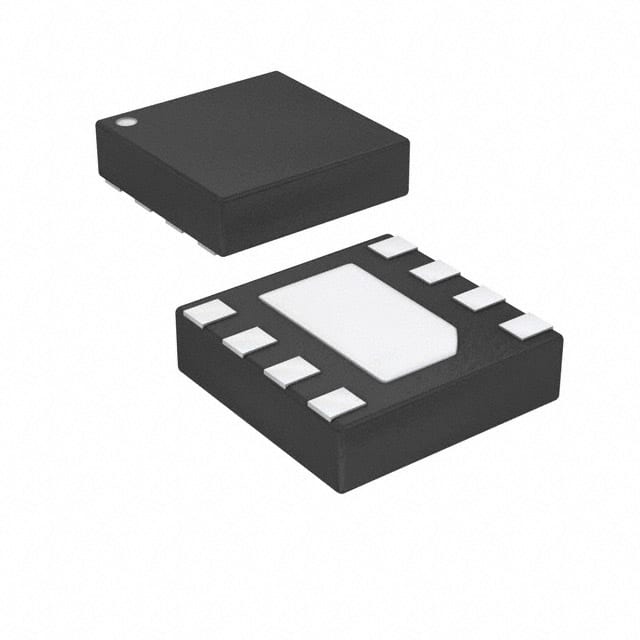ATTINY10-MAHR
Product Overview
Category
The ATTINY10-MAHR belongs to the category of microcontrollers.
Use
It is primarily used for embedded systems and small-scale applications that require low power consumption and compact size.
Characteristics
- Low power consumption
- Small form factor
- High performance
- Versatile functionality
Package
The ATTINY10-MAHR comes in a compact surface-mount package, making it suitable for space-constrained designs.
Essence
This microcontroller is designed to provide efficient processing capabilities while minimizing power consumption and physical footprint.
Packaging/Quantity
The ATTINY10-MAHR is typically packaged in reels or tubes, with quantities varying based on customer requirements.
Specifications
- Architecture: AVR
- Flash Memory: 1KB
- RAM: 32 bytes
- Operating Voltage: 1.8V - 5.5V
- Clock Speed: Up to 12MHz
- Digital I/O Pins: 6
- Analog Input Pins: 4
- PWM Channels: 1
- Communication Interfaces: SPI, I2C, UART
Detailed Pin Configuration
The ATTINY10-MAHR features a total of 8 pins, each serving a specific purpose:
- VCC: Power supply input
- GND: Ground reference
- Reset: Reset pin for system initialization
- PB0: General-purpose digital I/O pin
- PB1: General-purpose digital I/O pin
- PB2: General-purpose digital I/O pin
- PB3: General-purpose digital I/O pin
- PB4: General-purpose digital I/O pin
Functional Features
- Low power consumption enables battery-powered applications.
- High-performance AVR architecture allows for efficient execution of instructions.
- Multiple communication interfaces facilitate connectivity with other devices.
- On-chip analog-to-digital converter (ADC) enables precise measurement of analog signals.
- Built-in timers and PWM channels provide flexible timing and control capabilities.
Advantages and Disadvantages
Advantages
- Compact size allows for integration into space-constrained designs.
- Low power consumption extends battery life in portable applications.
- Versatile functionality enables a wide range of applications.
- Cost-effective solution for small-scale projects.
Disadvantages
- Limited flash memory and RAM may restrict the complexity of applications.
- Fewer I/O pins compared to larger microcontrollers may limit connectivity options.
- Lack of advanced peripherals may require additional external components for certain applications.
Working Principles
The ATTINY10-MAHR operates based on the AVR architecture, utilizing a combination of hardware and software to execute instructions. It follows a von Neumann architecture, where program instructions and data are stored in the same memory space. The microcontroller fetches instructions from memory, decodes them, and executes the corresponding operations. It interacts with external devices through its I/O pins and communication interfaces.
Detailed Application Field Plans
The ATTINY10-MAHR finds applications in various fields, including but not limited to:
- Internet of Things (IoT) devices
- Wearable technology
- Home automation systems
- Sensor networks
- Consumer electronics
- Industrial automation
- Automotive electronics
- Medical devices
Detailed and Complete Alternative Models
- ATTINY13A-PU: Similar to ATTINY10-MAHR but with higher flash memory capacity (1.2KB).
- ATTINY25-20PU: Offers more I/O pins (8) and larger flash memory (2.5KB).
- ATTINY85-20PU: Provides increased flash memory (8KB) and more I/O pins (8).
These alternative models offer expanded capabilities and can be considered based on specific project requirements.
In conclusion, the ATTINY10-MAHR is a compact and low-power microcontroller suitable for small-scale applications. Its versatile functionality, combined with its small form factor, makes it an ideal choice for various embedded systems. While it may have limitations in terms of memory and I/O pins, alternative models are available to address these constraints.
Lista 10 Vanliga frågor och svar relaterade till tillämpningen av ATTINY10-MAHR i tekniska lösningar
Sure! Here are 10 common questions and answers related to the application of ATTINY10-MAHR in technical solutions:
Q: What is ATTINY10-MAHR? A: ATTINY10-MAHR is a microcontroller from Atmel (now Microchip Technology) that offers low-power consumption and is suitable for small-scale applications.
Q: What are the key features of ATTINY10-MAHR? A: Some key features of ATTINY10-MAHR include 1KB Flash memory, 32B SRAM, 4 general-purpose I/O pins, and a 6-bit ADC.
Q: What are some typical applications of ATTINY10-MAHR? A: ATTINY10-MAHR is commonly used in applications such as smart home devices, wearable electronics, sensor nodes, and low-power IoT devices.
Q: How can I program ATTINY10-MAHR? A: ATTINY10-MAHR can be programmed using various development tools, such as Atmel Studio or Arduino IDE, by connecting it to a programmer/debugger via SPI or UPDI interface.
Q: Can ATTINY10-MAHR communicate with other devices? A: Yes, ATTINY10-MAHR supports serial communication protocols like I2C and SPI, allowing it to communicate with other devices such as sensors, displays, and external memory.
Q: What is the power consumption of ATTINY10-MAHR? A: ATTINY10-MAHR is designed for low-power applications and has a typical power consumption of around 0.2mA in active mode and less than 1µA in sleep mode.
Q: Can ATTINY10-MAHR drive external components directly? A: Yes, ATTINY10-MAHR can drive external components such as LEDs, small motors, and sensors directly through its general-purpose I/O pins.
Q: Is ATTINY10-MAHR suitable for battery-powered applications? A: Yes, ATTINY10-MAHR's low-power consumption makes it well-suited for battery-powered applications where power efficiency is crucial.
Q: Can ATTINY10-MAHR be used in industrial environments? A: While ATTINY10-MAHR is not specifically designed for industrial environments, it can be used in certain low-complexity industrial applications that require low-power microcontrollers.
Q: Are there any limitations to consider when using ATTINY10-MAHR? A: Some limitations of ATTINY10-MAHR include limited program memory (1KB), limited I/O pins (4), and a relatively low clock speed (up to 12MHz). These limitations should be considered when designing solutions with this microcontroller.
Please note that the answers provided here are general and may vary depending on specific use cases and requirements.


